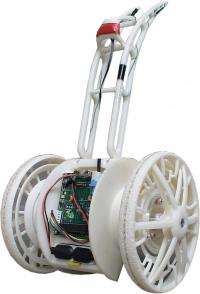November 12, 2011 report
iFling robot gets juiced for third design iteration

(PhysOrg.com) -- The team at the Coordinated Robotics Lab at the University of California San Diego (UCSD), which created the little iFling robot, says the iFling is now in the process of its third design iteration, and with added potential. This is a radio-controlled robot often described as a “self-righting little Segway-like vehicle.” Its activity is picking up and throwing ping pong balls. The robot was built using a 3-D printer, according to the video narration.
The iFling is stabilized via feedback control, which allows it to balance upright. The concept is likened to an inverted pendulum.
The UCSD team is showing a design that makes the iFling simply fun to watch. The machine is maneuverable, agile, and effective.
In picking up a ball, the iFling rolls over the ball and wedges it between the body and wheel. Throwing a ball is also achieved with precision. A printed circuit board is used to connect the electronics.
The latest videos show the iFling going through its deft motions. The narrator reports that the robot is in the process of its third design iteration. The iFling site comments on the progress the team has achieved.
“We have explored (through three major design iterations) the miniaturization and simplification of our original iHop concept to form a (non-hopping) self-righting Segway dubbed iFling that can pick up and throw ping-pong balls (or swack them around, using the leg as a hockey stick),” according to the lab’s site.
The UCSD iFling video comments that the iFling carries the potential to be automated so that multiple bots can play together; and to be scaled up, so that different-sized balls may be used.
Why bother focusing on enhancing a robot that picks up balls and throws them around? While such a robot may not directly address Italy’s finance problems, this lab at UCSD never did place global economics at the top of its wish list. What does interest the lab is reflected in an interview with Tom Bewley, who heads the Coordinated Robotics Lab.
The lab works on feedback control to impart stability to robots. Dr. Bewley is considered an expert on simulation, optimization, and control issues in robotics. He is the author of Numerical Renaissance: Simulation, Optimization, & Control.
His team turns its attention to continued improvements on its robots and to issue updated versions, like the present iFling.
“The Coordinated Robotics Lab is fundamentally a dynamics and control shop that does robotics,” he has said.
Its work has its roots in a hopping robot, dubbed iHop, which spawned other concepts, Switchblade, and iceCube. Together with iFling, they tell a story of innovative robot design. “We endeavor to create small, minimalist robots that can overcome large, complex obstacles via clever leveraging of advanced feedback control strategies,” he has said.
Not surprisingly, the first likely commercial application of the iFling is expected to be in the toy industry.
More information: robotics.ucsd.edu/iFling.html
via IEEE
© 2011 PhysOrg.com




















